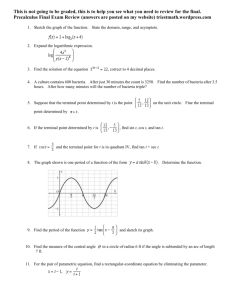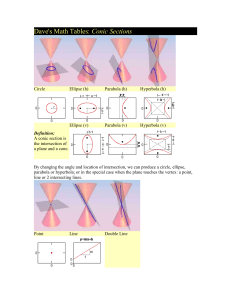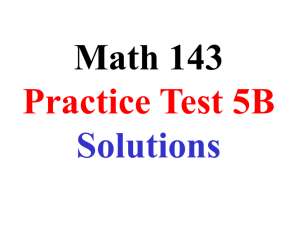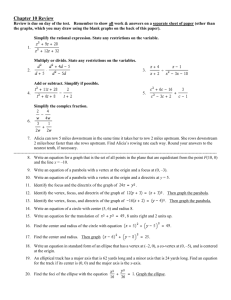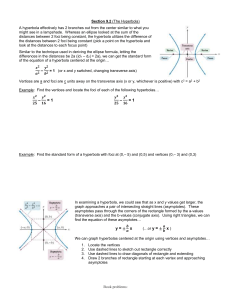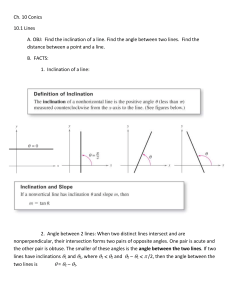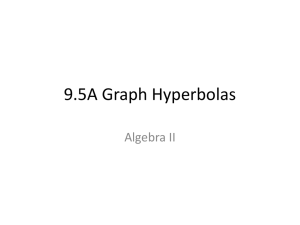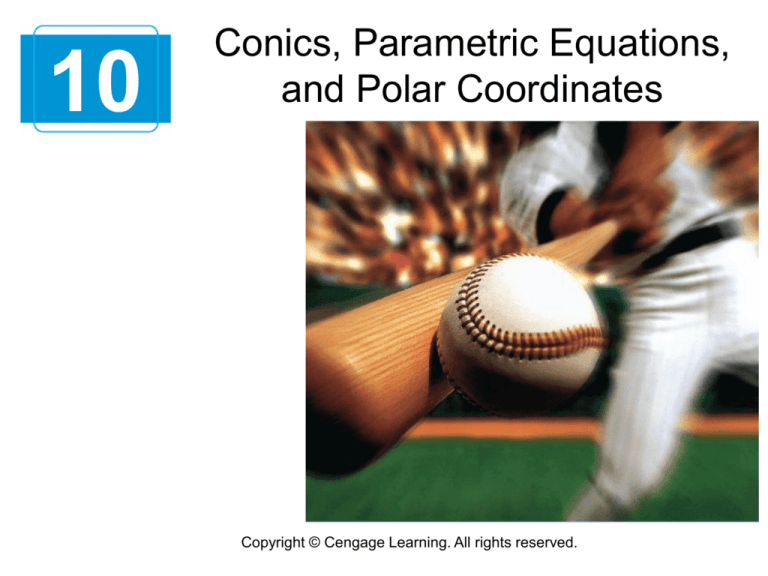
10
Conics, Parametric Equations,
and Polar Coordinates
Copyright © Cengage Learning. All rights reserved.
10.1
Conics and Calculus
Copyright © Cengage Learning. All rights reserved.
Objectives
Understand the definition of a conic section.
Analyze and write equations of parabolas
using properties of parabolas.
Analyze and write equations of ellipses using
properties of ellipses.
Analyze and write equations of hyperbolas
using properties of hyperbolas.
3
Conic Sections
4
Conic Sections
Each conic section (or simply conic) can be described as the intersection of a plane and a
double-napped cone.
Notice in Figure 10.1 that for the four basic conics, the intersecting plane does not pass through the
vertex of the cone.
When the plane passes through the vertex, the resulting figure is a degenerate conic, as shown in
Figure 10.2.
Figure 10.1
Figure 10.2
5
Conic Sections
You could begin as the Greeks did by defining the conics in terms of the intersections of
planes and cones, OR you could define them algebraically in terms of the general
second-degree equation
However, a third approach, in which each of the conics is defined as a locus (collection)
of points satisfying a certain geometric property, works best.
For example, a circle can be defined as the collection of all points (x, y) that are
equidistant from a fixed point (h, k).
This locus definition easily produces the standard equation of a circle
6
Parabolas
7
Stewart
| PF | x 2 ( y p) 2 | y p |
x 2 y 2 2 yp p 2 | y p |2 ( y p) 2 y 2 2 yp p 2
x 2 4 yp
x2
y
4p
8
Stewart
9
10
directrix: y=k-p = 1+0.5=1.5
11
My example:
y 2 6 y 8 x 25 0
y 2 6 y 9 9 8 x 25 0
( y 3) 2 8 x 16 0
( y 3) 2 8( x 2) 4 2( x 2)
Vertex (2,3)
p 2
Opens to negative x
Focus (h p, k) (-2 - 2,-3) (-4,-3)
Directrix x h p -2 2 0
12
A line segment that passes through the focus of a parabola and has endpoints on the
parabola is called a focal chord.
The specific focal chord perpendicular to the axis of the parabola is the latus rectum.
x 2 4 py
y p x 2 4 pp x 2 p
y
x2
2x
x
y '
4p
4p 2p
2p
s
2 p
2p
1 ( y ' ) 2 dx
2 p
2
x
2
dx
1
2p
2p
2p
4 p 2 x 2 dx
0
11
x 4 p 2 x 2 4 p 2 ln | x 4 p 2 x 2 | 0
p2
2p
1
2 p 8 p 2 4 p 2 ln | 2 p 8 p 2 | 4 p 2 ln | 2 p |
2p
13
2 p 8 p2
2 p 2 ln
2 p 2 ln( 1 2 ) 4.59 p
2p
CAS Implementation
14
One widely used property of a parabola is its reflective property.
In physics, a surface is called reflective if the tangent line at any
point on the surface makes equal angles with an incoming ray and
the resulting outgoing ray.
The angle corresponding to the incoming ray is the angle of
incidence, and the angle corresponding to the outgoing ray is the
angle of reflection.
One example of a reflective surface is a flat mirror.
Another type of reflective surface is that formed by revolving a
parabola about its axis.
A special property of parabolic reflectors is that they allow us
to direct all incoming rays parallel to the axis through the
focus of the parabola—this is the principle behind the design
of the parabolic mirrors used in reflecting telescopes.
Conversely, all light rays emanating from the focus of a
parabolic reflector used in a flashlight are parallel, as
shown in Figure 10.6.
15
Ellipses
16
Ellipses
An ellipse is the set of all points (x, y) the sum of
whose distances from two distinct fixed points called
foci is constant. (See Figure 10.7.)
You can visualize the definition of an ellipse by
imagining two thumbtacks placed at the foci, as
shown in Figure 10.9.
If the ends of a fixed length of string are fastened to
the thumbtacks and the string is drawn taut with a
pencil, the path traced by the pencil will be an
ellipse.
17
Stewart
18
Ellipses
The line through the foci intersects the ellipse at
two points, called the vertices.
The chord joining the vertices is the major axis, and
its midpoint is the center of the ellipse.
The chord perpendicular to the major axis at the center is the minor axis of the ellipse.
19
Figure 10.8
20
My example
Given:
4 x 2 16 x 9 y 2 18 y 11 0
4( x 2 4 x 4 4) 9( y 2 2 y 1 1) 11
4( x 2) 2 9( y 1) 2 11 16 9 36
( x 2) 2 ( y 1) 2
1
9
4
h 2, k 1, a 3, b 2 c a 2 b 2 5
Vertices : (2 3,1) (5,1) (2 3,1) (1,1)
Foci : (2 5 ,1) (2 5 ,1)
21
22
FYI
23
0<c<a
=> 0 < c/a < 1 => 0 < e < 1
24
25
26
good approximation
Hyperbolas
27
Figure 10.14
Hyperbolas
A hyperbola is the set of all points (x, y) for which the
absolute value of the difference between the distances
from two distinct fixed points called foci is constant.
(Note that for the ellipse it was sum)
The line through the two foci intersects a hyperbola at
two points called the vertices.
The line segment connecting the vertices is the
transverse axis, and the midpoint of the transverse axis is the center of the hyperbola.
One distinguishing feature of a hyperbola is that its graph has two separate branches.
28
( x c) 2 y 2 ( x c) 2 y 2 2a
( x c ) 2 y 2 ( x c ) 2 y 2 2a
x 2 2 xc c 2 y 2 x 2 2 xc c 2 y 2 4a 2 4a ( x c) 2 y 2
a ( x c) 2 y 2 xc a 2
a 2 ( x 2 2 xc c 2 y 2 ) x 2c 2 2 xca2 a 4
a 2 x 2 a 2c 2 a 2 y 2 x 2c 2 a 4
(c 2 a 2 ) x 2 a 2 y 2 a 2 (c 2 a 2 )
b 2 c 2 a 2 c 2 a 2 b 2
Note that for ellipse : c 2 a 2 b 2
b 2 x 2 a 2 y 2 a 2b 2
x2 y 2
1
a 2 b2
29
Note that for ellipse : c 2 a 2 b2
1)Transverse axis is horizontal
( x h) 2 ( y k ) 2
1
a2
b2
( y k )2
x h
1 no intersecti on
b2
( x h) 2
y k
1 x h a vertices
a2
( x h) 2 ( y k ) 2
1 1 | x h | a
a2
b2
2)Transverse axis is vertical
( y k ) 2 ( x h) 2
1
a2
b2
( y k )2
x h
1 y k a vertices
a2
( x h) 2
y k
1 no intersecti on
b2
( y k ) 2 ( x h) 2
1 1 | y k | a
a2
b2
30
Hyperbolas
An important aid in sketching the graph of a hyperbola is the
determination of its asymptotes, as shown in Figure 10.15.
Each hyperbola has two asymptotes that intersect at the center of
the hyperbola.
The asymptotes pass through the vertices of a rectangle of
dimensions 2a by 2b, with its center at (h, k).
The line segment of length 2b
joining (h, k + b) and (h, k – b)
is referred to as the
conjugate axis of the hyperbola.
Figure 10.15
31
( x h) 2 ( y k ) 2
1
a2
b2
( x h) 2
b
1 k
( x h) 2 a 2
2
a
a
Now consider :
y k b
b
b
y k ( x h)
a
a
( x h)
2
b ( x h) 2 a 2 ( x h) 2
b
a ( x h) 2 a 2 ( x h)
a
a 2 ( x h)
( x h)
b
a
( x h)
a
2
2
a 2 ( x h)
2
0
a 2 ( x h)
(( xx hh))
( x h)
2
a 2 ( x h)
2
a2
as ( x h)
In Figure 10.15 you can see that the asymptotes
coincide with the diagonals of the rectangle with
dimensions 2a and 2b, centered at (h, k).
This provides you with a quick means of sketching the
asymptotes, which in turn aids in sketching the
hyperbola.
32
Transverse axis is horizontal
x2 y2
1
4 16
y2
x 0
1 no intersecti on
16
x2
y 0
1 x 2 vertices
4
x2 y2
1 1 | x | 2
4 16
a 2, b 4 c a 2 b 2 20 2 5
Center (0,0)
Vertices (2,0)
Foci (2 5 ,0)
Rectangle [-2,2] [-4,4]
33
My example
y 2 16 x 2 64 x 208 0
y 2 16( x 2 4 x 4 4) 208 0
y 2 16( x 2) 2 208 64 144 122
y 2 ( x 2) 2
1
144
9
y 2 ( x 2) 2
1 | y | 12
144
9
a 12, b 3 c a 2 b 2 153
Center (2,0)
Vertices (2,12)
Foci (2, 153 )
Rectangle [2 3,2 3] [0 12,0 12] [1,5] [12,12]
34
35
36
37


